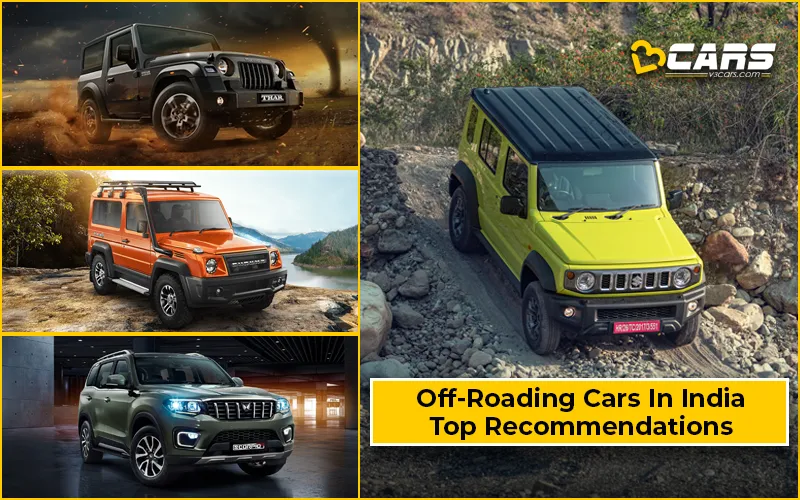Exploring The Thrill Of Off-Roading – Top Off-Roading Cars In India

Off-Roading in India: A Thrilling Experience
Off-roading is more than just a recreational activity; it's an experience that connects you with nature while testing your driving skills to the max. India's diverse topography, from the towering peaks of the Himalayas to the vast Thar Desert, provides a wide range of terrains to explore. Whether you're an experienced off-roader or a newbie looking to start, having the right vehicle is crucial for safety and performance.
Key Factors to Consider
Before diving into the list of off-roading cars, it's essential to understand what makes an off-road vehicle suitable for Indian conditions:
Ground Clearance: One of the most critical aspects of off-roading is ground clearance. It determines a vehicle's ability to clear obstacles like rocks, tree roots, and uneven terrain without getting stuck. In India, where roads can vary greatly in quality, having sufficient ground clearance is essential.
Four-Wheel Drive (4WD) or All-Wheel Drive (AWD): Off-roading cars often come equipped with either 4WD or AWD systems. These systems provide power to all 4 wheels, enhancing traction and stability on challenging surfaces like mud, snow, or sand.
Approach and Departure Angles: A vehicle's approach and departure angles are vital for tackling steep inclines and declines without getting stuck. Off-roading vehicles typically have improved angles to navigate obstacles more effectively.
Suspension and Tyres: A robust suspension system and off-road tires are essential for absorbing shocks and providing better grip on uneven terrain. Upgraded suspension and tires are common features in off-roading vehicles.
Note: Instantly Sell Your Old Car With V3Cars Sell Used Car Platform
Now, let's explore some of the top off-roading cars available in India, along with their specifications and prices.
Best Off-Road SUVs In India Under Rs. 20 Lakh
If you have a budget of under Rs. 20 lakh and want to buy a capable off-road SUV, your options are limited to the Maruti Suzuki Jimny, Mahindra Thar, Force Gurkha and the Mahindra Scorpio-N. While there are other SUVs, such as the Maruti Suzuki Grand Vitara and Toyota Urban Cruiser Hyryder, that offer all-wheel drive capabilities, the 4 SUVs we have chosen are based on robust ladder frame chassis instead of a monocoque platform. Besides, all 4 SUVs offer a part-time 4WD system, meaning the driver can manually engage or disengage 4-wheel-drive and switch between high and low range gear ratios, depending on the situation. The Grand Vitara and Urban Cruiser Hyryder, on the other hand, offer a full-time AWD system that automatically distributes power to all 4 wheels without any driver intervention. They also lack a low range like 4WD systems.
|
|
||||
|
|
|
|
|
|
|
|
|
|
|
|
|
|
|
|
|
|
|
|
|
|
|
|
|
|
|
|
|
|
|
|
|
|
|
|
Let’s take a quick look at what approach angle, departure angle and breakover angle mean. Approach angle is the maximum upward angle of an inclined surface that your SUV can drive over. An SUV with a higher approach angle can climb steeper slopes than an SUV with a lower approach angle. Departure angle is similar to approach angle, except it is measured at the back of your SUV. Hence, a car with greater departure angle can clear steeper declines without brushing the underside of the vehicle. The breakover angle is an apex formed by the vehicle's middle and the angles toward the rear and front wheels. A car will tip or even turtle if it crosses a surface that is high enough to cause the wheels to lose traction and even lose contact with the road surface.
Note: Now Find Out The Fuel Price In India Using V3Cars
What Is The Difference Between Four-Wheel-Drive (4WD) And All-Wheel-Drive (AWD)?
What distinguishes AWD from 4WD? Both AWD and 4WD systems channel power from your vehicle's engine to all four wheels, optimising traction. AWD employs a flexible connection that can adapt on-the-fly, at any speed, redistributing power to where it's most needed. On the other hand, 4WD links your front and rear wheels through a transfer case, evenly splitting power. It's intended for use at lower speeds and in rugged terrains.
Car manufacturers often use the terms 4WD and AWD interchangeably. Some advanced 4x4s incorporate additional equipment that enables them to mimic an AWD system, while certain AWD systems are equipped with off-road enhancements or terrain-specific driving modes, lending them capabilities akin to a 4x4.
In broad terms, AWD is tailored for on-road driving and light off-road usage, offering convenience to the majority of drivers who favour sedans, crossovers, or SUVs. Conversely, 4WD is engineered for off-road endeavours and aiding larger, weightier vehicles in escaping challenging predicaments. It demands more driver involvement and is commonly found in larger SUVs and trucks, making it the preferred choice for those frequently engaged in towing operations.
Is AWD or 4WD Better For You?
If your typical driving terrain consists mainly of well-paved roads, occasionally venturing onto light off-road paths to access campgrounds or trailheads, then an AWD vehicle is the more suitable option. However, if your off-road excursions are more demanding, involving muddy tracks, rocky terrains, slippery slopes, or if you often find yourself needing to tow heavy trailers, then a 4WD vehicle is the better fit.
Also Read: How To Make Your Car Last 2 Lakh Kilometres – V3Cars Guide
from Latest Car's News & Updates by V3Cars https://ift.tt/XZPAQjO
via IFTTT

Post a Comment